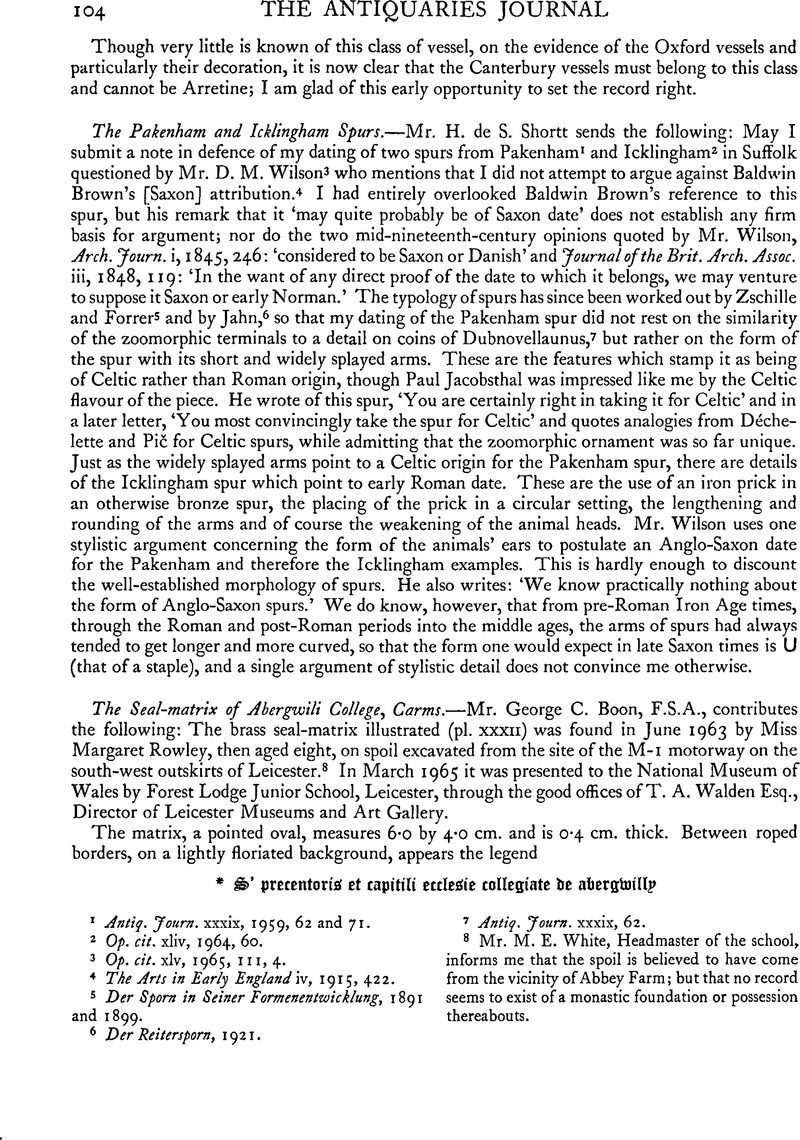No CrossRef data available.
Article contents
The Seal-matrix of Abergwili College, Carms.
Published online by Cambridge University Press: 29 November 2011
Abstract

- Type
- Notes
- Information
- Copyright
- Copyright © The Society of Antiquaries of London 1966
References
page 104 note 8 Mr. M. E. White, Headmaster of the school, informs me that the spoil is believed to have come from the vicinity of Abbey Farm; but that no record seems to exist of a monastic foundation or possession thereabouts.
page 105 note 1 Martyred, probably under Maximian: cf. Cabrol, F. and Leclercq, H., Dictionnaire d'Archéologie Cirétienne, x, 2 (1932), 2699–2729Google Scholar.
page 105 note 2 Cf. Muriel Clayton, Cat. of Brass Rubbings (Victoria and Albert Museum, 1929), pls. 15–19, passim, contrasting e.g. with pls. 14 and 20.
page 105 note 3 The information was brought to light by the late William Greenway, in ‘Bishops and Chapter of the Diocese of St. Davids, 1280–1437’(Cambridge, M.Litt., 1958, pp. 208–9).
page 105 note 4 No traces remain at Abergwili (which was and is the residence of the Bishop of St. Davids) of the college buildings: Roy. Comm. Anc. and Hist. Mons. (Wales and Monm.), v, County of Carmarthen (1917), 4, note ‡
page 105 note 5 e.g. in Dugdale's, W.Monasticon Anglicanum (edd. Caley-Ellis-Bandinel), vi, 3 (1846), 1376–7Google Scholar.
page 105 note 6 Cat. Pat. Rolls, 1281–92, p. 462.
page 105 note 7 Cal. Pap. Letters, 1198–1306, p. 508.
page 105 note 8 Clark, G. T., Cartae et Alia Munimenta.… (Cardiff, 1910), iii, pp. 565–7Google Scholar.
page 105 note 9 Cal. Pat. Rolls, 1292–1301, p. 20.
page 105 note 10 Ibid. 1281–92, p. 462.
page 106 note 1 Details in this paragraph from Dugdale (see under p. 105, n. 5, above); Brecon, ibid. 1496–1500. Under Elizabeth (Inspeximus, Wm. & Mary), there was a suit in the Exchequer regarding the possessions of the college, which had been illegally obtained by two persons under an erroneous application of the statute for the dissolution of chantries. The college, of course, continues to this day.


